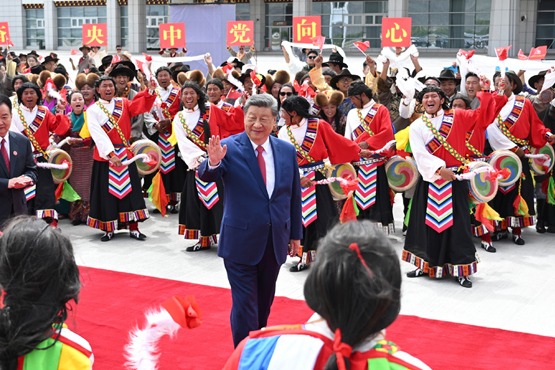Robust economy attracts talented entrepreneurs


Guangdong, in South China, has the country's largest provincial population and the highest growth in resident numbers, according to the seventh census conducted by the National Bureau of Statistics.
"Guangdong, especially the prosperous Pearl River Delta region, is very attractive to talented people thanks to its robust economic and industrial development since the start of the reform and opening-up in the late 1970s," said Wang Guangzhou, a population and labor economy researcher with the Chinese Academy of Social Sciences.
According to the data, which was released last month, Guangdong has recorded China's highest population growth, with the number of residents rising to 126 million in the past 10 years.
In that decade, Guangdong added more than 21.7 million people, with a relatively low number of seniors-12.35 percent-in its population, according to the data.
"In recent years, more people from less-developed areas inside and outside of Guangdong have moved to the economically developed Pearl River Delta for better job opportunities," Wang said.
In a recent interview with Nanfang Daily in Guangzhou, the provincial capital, he said Guangdong's rising population has helped the province develop its economy and upgrade local industries.
"The rapid rise in the population has been an important engine driving the local economy and helped Guangdong develop into an economic powerhouse in South China," he said.
The provincial statistics authority said that despite the COVID-19 outbreak, Guangdong's economy grew to 11 trillion yuan ($1.72 trillion) last year, a rise of 2.3 percent from 2019.
"With its high level of marketization, Guangdong has become very attractive to talented people during the past four decades," Wang said.
"Only by adhering to the path of marketization can a region become more prosperous."
From a long-term perspective, Guangdong's large population will be of great importance to its social and economic development, according to Wang, who called for coordinated development of the provincial economy.
Last year, the combined GDP of nine cities in the Pearl River Delta was 8.95 trillion yuan, with Guangzhou, Shenzhen and Foshan surpassing 1 trillion yuan each.
"The high-quality development model was not only about industrial upgrading in the delta, but also about the coordinated development of the regional economy," Wang said.
Guangdong, one of South China's most dynamic economies, has been making efforts to accelerate the development of the Guangdong-Hong Kong-Macao Greater Bay Area since in-depth development plans for regional cooperation were unveiled in 2017.
With a population of approximately 71.2 million, the Greater Bay Area includes nine cities in Guangdong-Guangzhou, Shenzhen, Zhuhai, Foshan, Dongguan, Zhongshan, Jiangmen, Huizhou and Zhaoqing-and the Hong Kong and Macao special administrative regions.
The Greater Bay Area, whose 56,000 square kilometers enclose the entire Pearl River Delta, is South China's largest and richest economic region.
A 2019 outline development plan said the Greater Bay Area has regional advantages, a strong economy, innovative power and advanced engagement with international business.
Those factors will see the area become a dynamic world-class city cluster, a global technology and innovation hub, a key component of the Belt and Road Initiative and a showcase for in-depth cooperation between the Chinese mainland, Hong Kong and Macao. It will also become an ideal place to live, work and visit, the document said.
Ma Xingrui, Guangdong's governor, said the Greater Bay Area's total economic value was 11.5 trillion yuan last year, a rise of 1.4 trillion yuan from 2017.
Moreover, 21 companies in the region were listed in the Fortune Global 500 List.
By the end of last year, Guangdong had 53,000 State-level high-tech enterprises, a rise of about 20,000 from 2017, according to Ma.
"Remarkable progress has been made in the development of the Greater Bay Area, with enhanced comprehensive strength and cooperation between Guangdong and neighboring Hong Kong and Macao," he noted during a recent news conference.
Construction of the transportation infrastructure means the "one-hour life circle"-the ability to travel between major cities in just 60 minutes-has been accelerating in the Greater Bay Area, especially with high-speed rail coverage exceeding 1,200 kilometers.
Following the 2018 opening of the Hong Kong-Zhuhai-Macao Bridge, it takes just 30 minutes to drive from Hong Kong to Zhuhai or Macao.
An innovation and technology corridor linking Guangzhou, Shenzhen, Hong Kong and Macao and an innovation network have also begun to take shape with connected scientific facilities and technologies between Guangdong, Hong Kong and Macao, Ma said.
So far, Guangdong has offered more than 10,000 large scientific instrument applications to users in Hong Kong and Macao. It has also allocated 150 million yuan of cross-border research funds.
"Nine cities in the Pearl River Delta have attracted almost 9,000 innovative people from overseas," Ma said.
The integration of life and work with Hong Kong and Macao has also been accelerating, with 95,000 students from Hong Kong and Macao studying in Guangdong's primary and middle schools, and 14,000 students from the cities attending its universities.
A total of 187,000 people from Hong Kong and Macao have taken up pension, unemployment and work-related injury insurance in Guangdong, Ma said.
Frank Chan, a Hong Kong native who started his own business in Shenzhen's Qianhai district in 2019, said, "The Greater Bay Area's strength in cultural and technological innovation, especially in Shenzhen, is very attractive."
After graduating from the Hong Kong University of Science and Technology, Chan established a studio for the design and creation of cartoon and animated characters in the Shenzhen-Hong Kong Youth Innovation and Entrepreneurs Hub, a platform that seeks to encourage more young people from Hong Kong and Macao to start businesses in the mainland city.
In the past three years, Guangdong's strong business environment has attracted more than 50,000 Hong Kong- and Macao-invested enterprises, with more than 4,000 young people from the two cities starting businesses in the province.
- Parade brings service members' dreams alive
- China activates Ningxia-Hunan power line
- Autonomous taxis drive Hainan's smart tourism
- Shenyang exhibit showcases historical justice
- Program aims to popularize awareness of disability prevention countrywide
- Death toll rises to 5 amid heavy rains in Inner Mongolia's Ordos





































